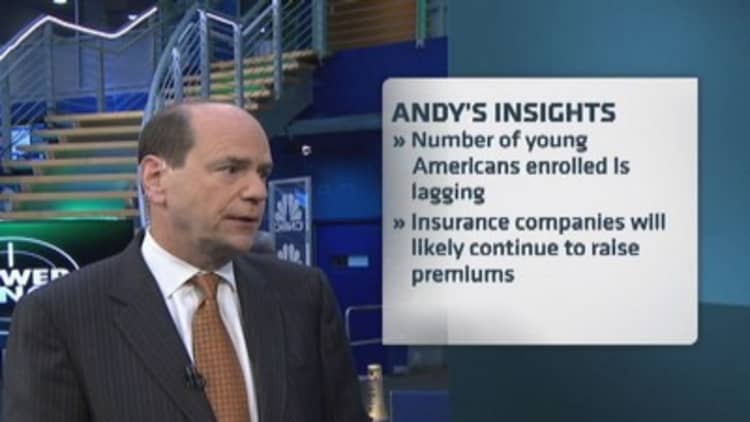At least 5.4 million people without health insurance have obtained coverage since last September—and that number will likely climb in coming weeks, a new survey found.
But even a surge of Obamacare exchange enrollments in March—the majority of which weren't captured by the survey—will probably still leave the United States several millions of people shy of a recently revised government projection that 13 million previously uninsured people would have coverage by the end of this year.
Nonetheless, "This is a great result, it's really exciting, it's really encouraging," said Katherine Hempstead, director of coverage for the Robert Wood Johnson Foundation. The organization helped fund the survey, which was conducted by researchers from the nonpartisan Urban Institute, and questioned 7,500 adults ages 18 to 64.
Read MoreFinal Obamacare deadline (for real!) is tax day
Still, Hempstead said, "it's really too early to say" if the trend is strong enough to reach the Congressional Budget Office's estimate of 13 million newly insured people by Dec. 31.
"There's still a lot uninsured people out there," she noted. Experts estimate that between 35 million and 40 million Americans currently lack health insurance.
Changes in the uninsured rate are being closely watched by both supporters and critics of Obamacare, since the law's main goal is to reduce the number of people without health coverage.
Affordable Care Act opponents say most of the 7.1 million people who had enrolled in private plans via government exchanges as of Monday previously had plans that were rendered noncompliant by the new law.
If that is the case, their argument goes, then Obamacare has primarily forced many people to exchange cheaper plans for more expensive coverage, and done little to reduce the uninsured rate—even as the mandate that most people obtain coverage kicks in this year.
The Urban Institute's survey found that the percentage of uninsured adult Americans fell from 17.9 percent as of last September, the month before Obamacare's open enrollment began, to 15.2 percent as of March 6.
By the end of December, the rate had only dropped to 17.5 percent.
Read MoreInsurance a tough sell for young? Blame mom and dad
Therefore, the majority of the decrease came in the first two months of 2014, when the Obamacare exchanges were seeing sharp increases in enrollment for both private plans and government-funded Medicaid coverage.
Because the survey ended March 6, it does not include much of the effect seen from the 2.9 million or more people who enrolled in Obamacare plans via the exchanges that month. An unknown percentage of those people were previously uninsured.
The rate drop seen in the survey was more pronounced in states that have expanded eligibility for Medicaid for low-income adults.
In Medicaid-expansion states, the uninsured rate went from 16.4 percent as of September to 12.4 percent as of March—an average 4 percent drop.
In nonexpansion states, the uninsured rate went from 19.6 percent to 18.1 percent over the same period—an average decrease of just 1.5 percent.

About half the states have expanded Medicaid eligibility.
In states that did not, many poor adults are barred from Medicaid and from receiving federal subsidies to offset the cost of private Obamacare plans, which are available to people earning more than them.
That so-called coverage gap resulted from the Supreme Court decision that upheld Obamacare's legality, while leaving Medicaid expansion decisions up to individual states.
Although open enrollment in Obamacare private plans ended Monday, the total number of people insured via the exchanges will likely grow in coming months.
Read MoreActavis: See positive impact from Obamacare
An unknown number of people have been granted a grace period this month to finish the enrollment process they began on the exchanges before the deadline, but were unable to complete because of technical snarls. The deadline for such enrollments on HealthCare.gov, the federal exchange selling insurance in 36 states, is April 15, a date that has also been selected by several state-run exchanges with grace periods.
Others will be allowed to enroll in private plans if they have so-called qualifying life events, such as losing their employer's health coverage, getting married or divorced, or having a child. And enrollment in Medicaid or the CHIP program, a government plan that covers children, is open year-round.
Timothy Jost, a professor at Washington and Lee University School of Law and an expert in the health-care reform law, said he expects continued growth in the numbers of newly insured people this year, particularly in Medicaid expansion states.
Jost also predicted that the numbers of uninsured who signed up on the exchanges in March is "going to make a significant difference" in the overall uninsured rate.
"We're not going to get there," Jost said, referring to the CBO's estimate of 13 million newly insured people this year.
But, "we're going to get closer," he said.
—By CNBC's Dan Mangan.


